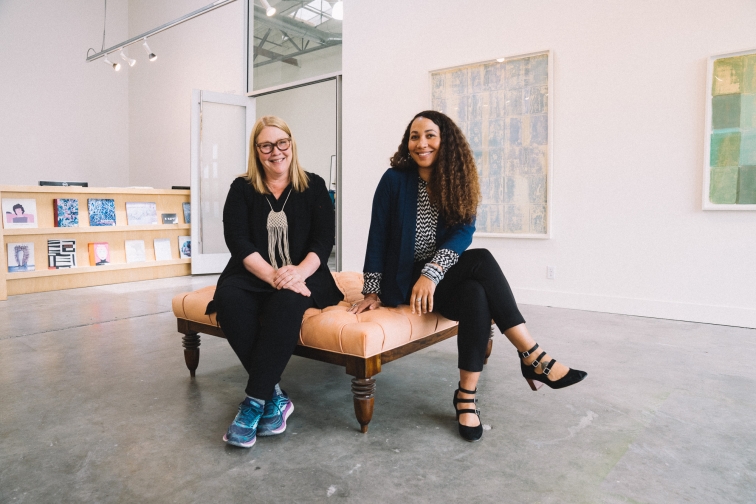Category: Paulson Fontaine Press
African American Artists at Paulson Bott Press: An Interview with Pam Paulson and Rhea Fontaine
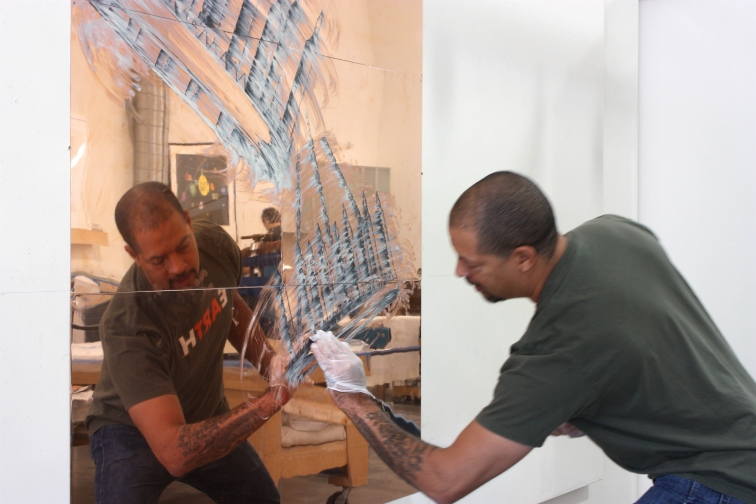
In its 20-year history, Paulson Bott Press has worked with an unusually high number of African American artists, including Edgar Arceneaux, Radcliffe Bailey, McArthur Binion, Thornton Dial, the Gee’s Bend quilters, Lonnie Holley, David Huffman, Kerry James Marshall, Martin Puryear, Lava Thomas, and Gary Simmons. Kenneth Caldwell sat down with Pam Paulson and Rhea Fontaine to talk about their experiences with some of these artists.
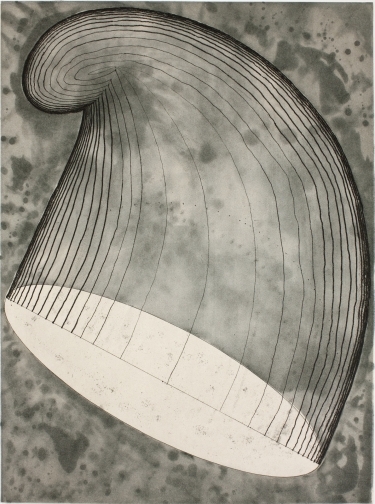
A number of the artists you’ve invited to make prints with you have been African American. Was there an intentional strategy?
Pam Paulson: We saw that there was a real vacuum to be filled. There was no one really representing artists of color in a big way.
Rhea Fontaine: And not just in fine art print publishing, but in the larger art world.
PP: Prints are democratic. They make an artist’s work affordable, giving more people the opportunity to get into the art market. We’ve always wanted to have wide-ranging conversations with a broad audience. At the same time, whenever we invite artists to work with us, it’s because we respond to their art.
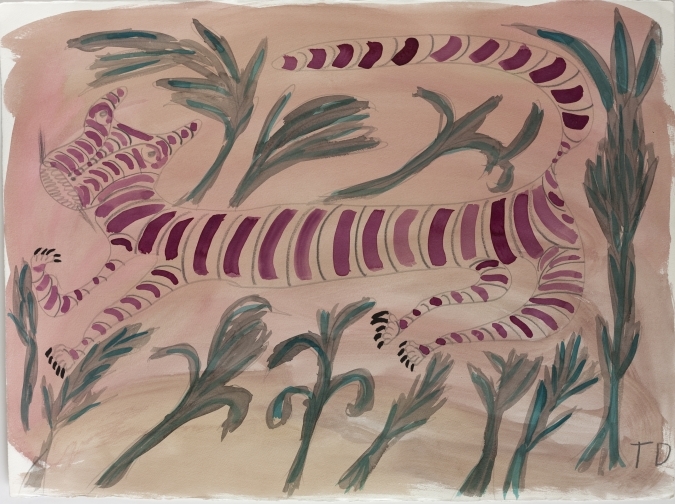
RF: There is a real moment right now for artists of the African Diaspora in institutions because audiences want to see these voices better represented. I was at the Whitney Museum’s inaugural exhibition, America Is Hard to See, and it was so good to see paintings by Al Loving, Alma Thomas, Noah Purifoy, and many others who, at points, were overlooked by history.
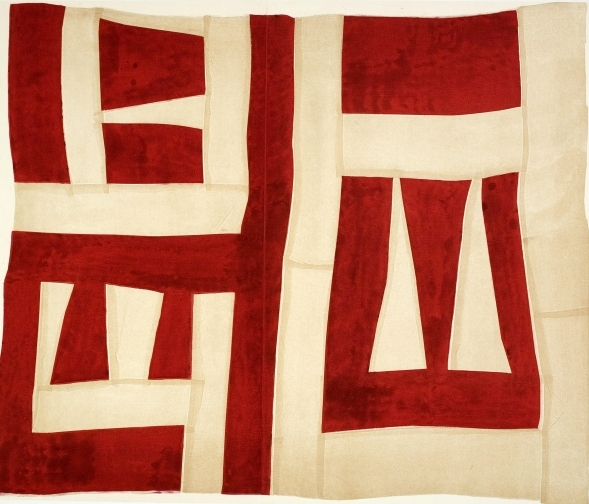
Talk about how you ended up working with the Gee’s Bend quilters.
PP: I went to New York at the end of 2002 and took my family to the Whitney Museum when the Gee’s Bend quilt show was there. We saw the beauty in the patterns and the improvisational genius. Their work was the visual equivalent of jazz.
Then my dad, who was in his mid-80s at the time, was at my house one night, and I was showing him the catalog for the show. I told him, “I was so blown away by this, Dad. You would have loved it.” And he said, “Why don’t you make prints for them?”
But we needed a way in. We couldn’t just walk into Gee’s Bend and ask these ladies to come make prints. We hit a lot of dead ends. Finally I called up Radcliffe Bailey, who had told me he had been to Gee’s Bend. I asked him, “Would you drive down there with me? I want to see if I can get some of the quilters to make prints with me.” The next night, he was at a dinner in Atlanta with a group of art people, and Matt Arnett was there—and Matt’s family represents the Gee’s Bend quilters. Radcliffe knew Matt because they grew up in the same town. He sat next to Matt and said, “My friend Pam, who I make prints with, wants to make prints with the Gee’s Bend quilters.”

Matt called me the next day. Then we were on the phone for the better part of a week. He really wanted to make sure that we were sincere and in no way going to take advantage of the quilters. He was also really interested in taking their work out of the purview of craft and putting it under the purview of art. The show at the Whitney had started to do that, of course, but working in another media besides quilting was going to take it one step further.
At one point, I said to Matt, “If they come and we don’t get anything, I don’t care. I’m just in it for the experience of trying.” And he was satisfied with that, so the quilters came to our studio.
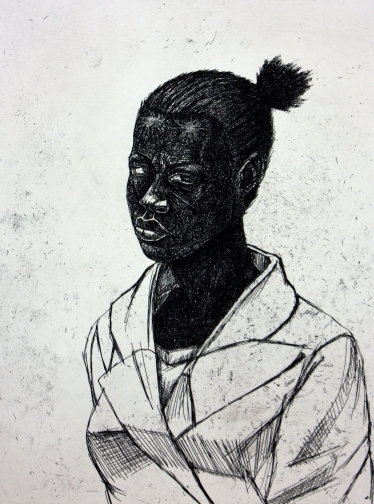
RF: It was our first time working with textile-based artists. Pam and Renee devised this idea of working with soft ground. We had no idea that the translation would even meet our expectations, but it far exceeded them. I came in the day after our printers started working with the quilters, and there were already so many works on the walls. It’s like we dove into a whole new world.
PP: It was so rewarding. It was like being at church. There was a lot of song and praise and gratitude going on while they worked. It was one of the most fun projects we’ve ever done.
Then after we did the prints, we took them to the print fair in New York the next year, and Jo Carole Lauder from the Foundation for Art and Preservation in Embassies saw them. She asked us to do prints with the quilters for their program. So four of the quilters did an edition of 50, and they are placed in US embassies worldwide.
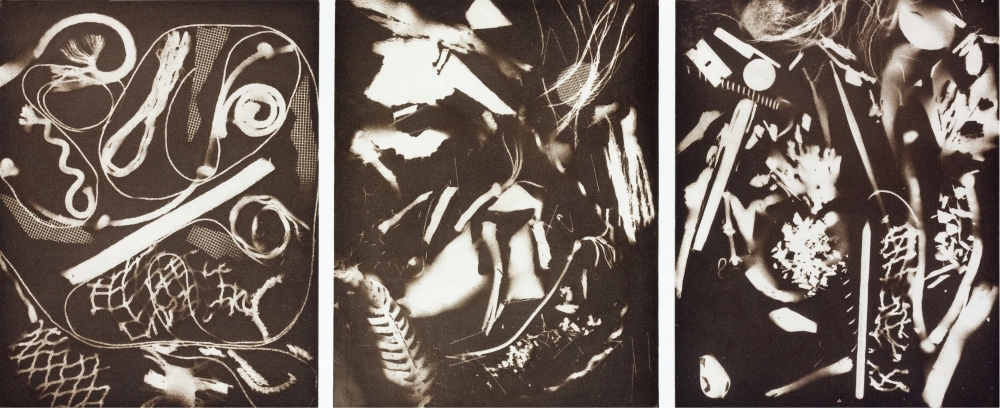
After Gee’s Bend, David Huffman and Lonnie Holley came, didn’t they?
RF: Yes. David is a good friend and someone whose work I have admired for many years. He is the first artist we published who was working with the stereotypical iconography of race in America. One of his early characters, named Trauma Eve, made a major impact on me. His fearless exploration of themes related to the legacy of slavery, postindustrialism, Afrofuturism, and the counterculture continue to fascinate.
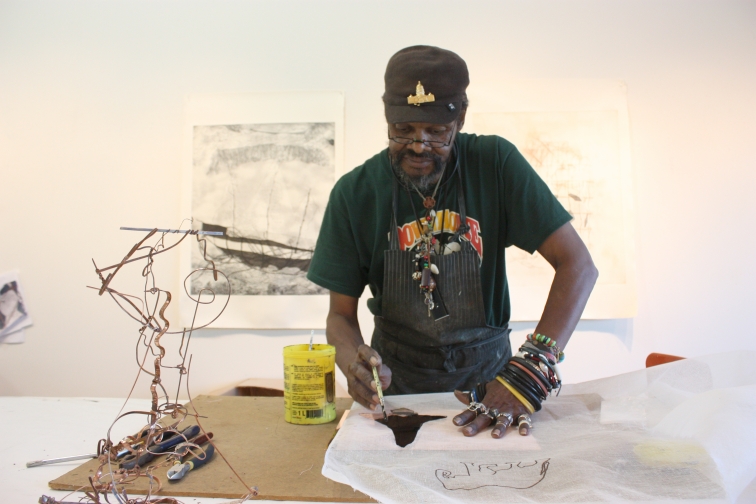
How did Lonnie Holley come to work with you?
PP: The Arnetts have a large collection of artworks by self-taught artists from the South. After the Gee’s Bend experience, we went down the Arnetts’ Atlanta warehouse, which is gigantic, and talked about all the different artists they collected. Lonnie Holley was in their collection—his sculptures using found objects were beautiful. Lonnie also introduced the Arnetts to Thornton Dial, a groundbreaking African-American artist known for his large-scale assemblages using found objects.
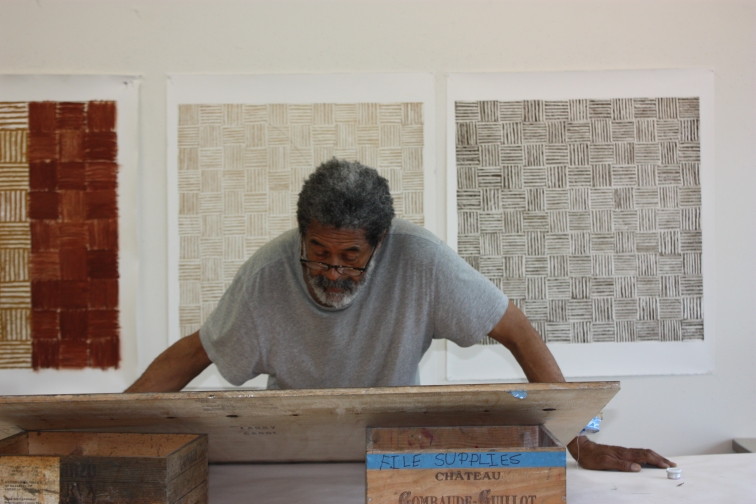
RF: People like the Arnetts, who support the Gee’s Bend quilters, and Lowery Stokes Sims, whose pioneering work at the Metropolitan Museum and the Studio Museum in Harlem introduced so many minority artists to larger audiences—these are the people who are taking risks that others aren’t willing to take, saying things that other people aren’t willing to say, seeing things that other people are not seeing. We’ve always wanted to connect ourselves with that type of visionary. Because of them, a number of extremely talented artists have become known to us and the world at large.
“Celebrating 20 Years” at the de Young Museum

On July 16, “Paulson Bott Press: Celebrating Twenty Years” opened in the Anderson Gallery of San Francisco’s de Young Museum. The show celebrates the Achenbach Foundation for the Graphic Arts’ acquisition of the Paulson Bott Press archive, which includes more than 500 prints from more than 40 artists. Featured artists in the exhibition include: Tauba Auerbach, Mary Lee Bendolph, Chris Johanson, Margaret Kilgallen, Martin Puryear, and Gary Simmons.
“It was wonderful to see a few of our former master printers on the day we first saw the exhibition at the de Young,” says Co-Founder, Pam Paulson. “Looking back and remembering all the talented and dedicated people who have been a part of our story is humbling. Each person involved with the press has contributed their unique gifts and enriched the prints we have produced and our capacity to get them out in the world.”
Gallery Director, Rhea Fontaine adds, “We are grateful for the opportunity to share our archive with a wide audience through the Achenbach acquisition and programming at the de Young. To know that our artists, many of whom are minorities and women, will be a part of this visual history and legacy is thrilling for us.”
Pictured from left to right: Rhea Fontaine, Pam Paulson, Alexander Groshong, Sam Carr-Prindle, and Renee Bott.
Paulson Bott Press: Celebrating Twenty Years
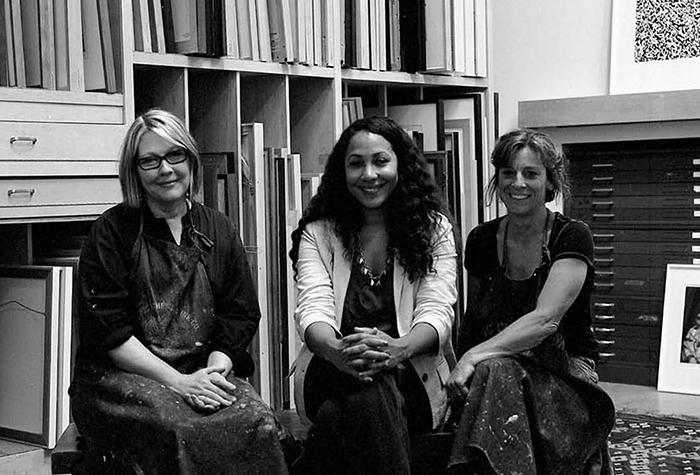
Founded by Pam Paulson and Renee Bott in 1996, Paulson Bott Press celebrates 20 years of intaglio fine art. Having launched the studio with a series of prints by Chris Brown, the press has gone on to work with numerous renowned and emerging artists.
Paulson, who has a background in fine art, began her printing career in San Francisco, California. “I wasn’t a printer, but Kathan Brown at Crown Point was looking for people who had the capacity to think on their feet and physically manipulate things and who knew enough about art not to be stupid with the artists,” Paulson says. “Once I had done a couple projects at Crown Point, I was completely hooked. I was watching other people make things. It was a puzzle that you had to figure out, and it was glorious. I loved it. I make things all day, and what really connects me to art is making things. That’s what I am supposed to do.”
Renee Bott was a colleague of Paulson’s at Crown Point. “Pam had the big picture, the broader vision, while I like having the pencils in the right place: I like order,” Bott says. “She was very optimistic from the outset. I’m the one who said, ‘Okay, if we’re going to do this, we need to order a press, and it should be made this way. When I started working as a printer and working with artists, I felt like I was home. I was home. I had arrived.”
Paulson Bott considers every print that gets ripped up, or kept, as a record of what the press is doing and has diligently documented the work with a time capsule that plots history. This includes the process of working with established artists like Martin Puryear and Ross Bleckner and younger artists like Tauba Auerbach and Clare Rojas. This year, the Achenbach Foundation for Graphic Arts acquired the archive of Paulson Bott Press.
“We started this from the very first day,” Bott says. “We understood that if we created something, we wanted it to have a legacy. When there is a catalog raisonné of the work that we’ve made, we want to look back and see a strong vision.”
To celebrate the acquisition, the Foundation will host a commemorative exhibition at the de Young Museum’s Anderson Gallery featuring 20 artists who have worked at the press, including Tauba Auerbach, Mary Lee Bendolph, Chris Johanson, Margaret Kilgallen, Martin Puryear, and Gary Simmons.
“We are interested in a broad platform with a mix of artists,” says Rhea Fontaine, Paulson Bott’s gallery director. “We are very focused on artists who add to the conversation in the realm of the work that they are doing, not just what we are doing.” The press will concurrently celebrate its catalogue with a retrospective on its Twitter and Facebook pages. Follow the conversation under the hashtag #20years20stories.
The show at the de Young will open next month on July 16, running through October 23, and can be viewed with general admission access.
Tickets can be purchased online or at the museum.
Sharing the Passion. An Art Collection at Stanford.
Recently we had the pleasure of visiting some of our collectors at their home on the Stanford University campus.
This couple has been collecting since the 1970s and has put together a stunning collection of prints, photos, and works on paper. With an early focus on Lichtenstein and Warhol, the collection now includes seminal works by Ansel Adams, Robert Bechtle, Damien Hirst, Ellsworth Kelly, Alex Katz, Sol LeWitt, Chris Ofili, Robert Rauschenberg, and Ed Ruscha, to name a few. We were thrilled to see etchings that we made with Isca Greenfield-Sanders and Christopher Brown on the walls of this midcentury home designed by Bates Elliot.
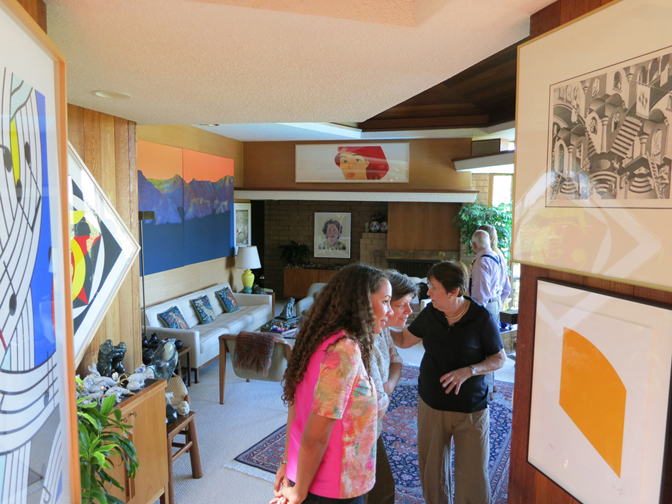
One of our friends is a recently retired engineering professor at Stanford University, where he taught for 50 years. His work in the field of neural engineering led much of the modem technology we all enjoy today. During the lovely lunch that our other friend prepared for us, he told the story of their introduction to visual art by fellow professor, Albert Elsen.
Elsen was a leading Rodin scholar at Stanford and also pivotal in the relationship that Stanford began in the 1970s with B. Gerald Cantor, the longtime supporter of the university’s art program, for whom the campus museum is named. It was Elsen who got our friends started on this collecting pursuit as he was able to communicate to the value of art. Elsen’s passion was contagious.
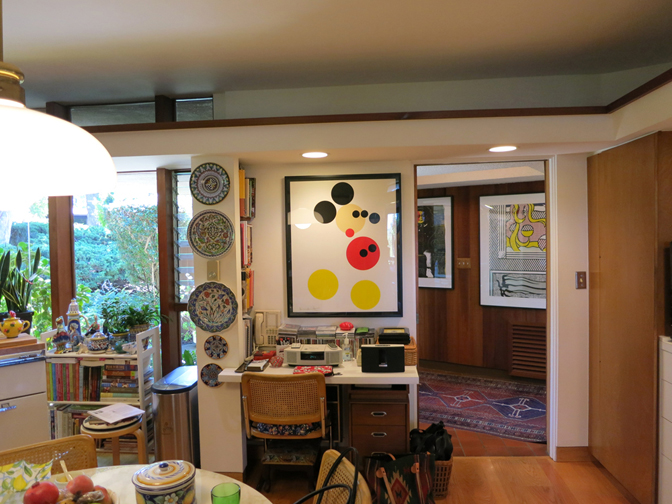
It was fascinating to hear the story of the beginning of their lifelong engagement with the arts. It brought to mind the ongoing discussion about how the visual arts community connects with enthusiasts in the science and technology fields. Elsen wrote a book titled Purposes of Art: Introduction to the History and Appreciation of Art. The idea of purpose, as complicated and diverse as it may be, seemed so clear to me while standing in the middle of this collection. To be surrounded by their visual expressions of thought and spirit gathered over a lifetime was truly invigorating.
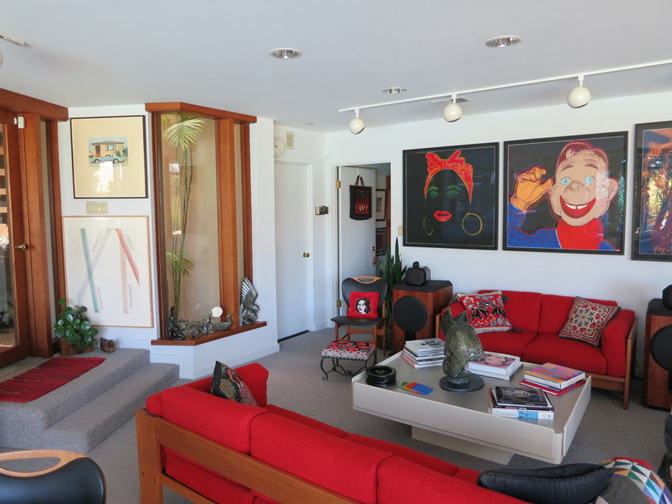
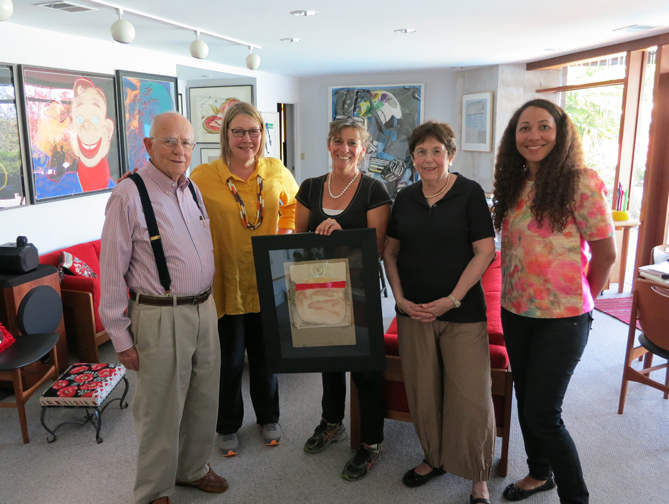
Shaping a Master Printer
As part of the exhibit “Closely Considered – Diebenkorn in Berkeley” at the Richmond Art Center, Renee Bott was asked to speak this last Sunday on her experience working with Richard Diebenkorn. Here are some of her recollections.
By Renee Bott
When I look back at the years I worked with Richard Diebenkorn in the studio of Crown Point Press, I appreciate how that experience shaped my vision of what it meant to be an artist and, in turn, what it meant to be a printer. Over four years, Dick and I worked together on a total of four projects. We created a total of 20 editions.
I was 24 years old in 1985, and only a few months prior to meeting Dick, I received my master’s degree from the California College of Arts and Crafts (as it was then known) and was hired as a printer at Crown Point Press. At that time, Crown Point Press was located in downtown Oakland where Broadway intersected with San Pablo Avenue in a beautiful old retail space. Kathan Brown asked me to step in and help the three senior printers make and print the largest, most ambitious color etching that Diebenkorn ever created: Green, 1986.
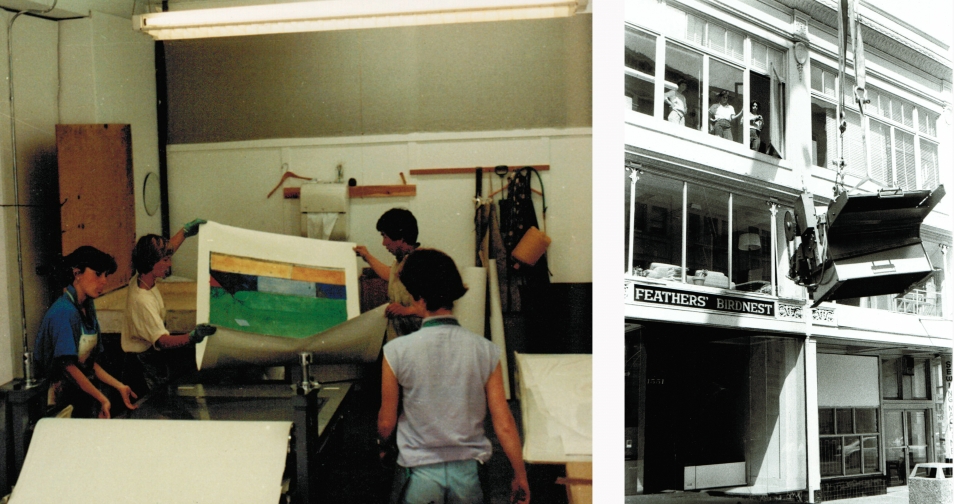
As I worked in the back room steel-facing and preparing enormous plates, I was worried that I needed to be perfect. But Dick, with his certainty and quiet confidence, warmly welcomed me into his work ethos, a journey that accepted all, imperfections included.
Years later, the Loma Prieta earthquake struck and displaced Crown Point Press from its Folsom Street studio. It was an uncertain time, as Crown Point was forced to find temporary refuge for the gallery and studio. Kathan found a space several blocks south of the old location. It was an old garage that ran west to east for one city block between Folsom and Shipley.
The space was dank and dark, with florescent tubes that cast a hard blue light—a stark contrast to the beauty and grace of the Folsom Street studio. The earthquake had disturbed the homes of thousands, including the city rats. The rats often visited us, scurrying along the pipes that ran over our heads. After a while, our squeals of horror turned to nonchalance as we realized that they, too, were just looking for a new home.
It was in this environment that Kathan asked me to lead a project with Dick to make a set of small etchings for Arion Press’s book of poems by Yeats. Despite the chaos, I remember feeling so grateful to be given this chance to work with Dick again, even if we were in what felt like an underground cave. At one point near the end of that project, Dick, Kathan, and all of the printers gathered for lunch around a small coffee table. A rat ran by on a pipe above our heads, and a silence descended on the group. We all prayed that Dick would not notice our visitor. After an awkward moment, Dick smiled and asked “Was that one of our furry friends?” We all laughed hysterically. Dick was such a humble man. I believe he felt gratitude that we were all there with him, working together, even if it meant having to work around “furry friends.”
The six small plates created for the Yeats books were presented to Andrew Hoyem of Arion Press at a lunch prepared at the Dienbenkorns’ Healdsburg home. We drank crisp white wine and ate the lovely salmon that Phyllis, Dick’s wife, had prepared. After lunch, Dick asked me to show Andrew the prints. I untied a small portfolio containing the six images. Carefully turning the prints over like pages in a book, I gave everyone a moment to admire the work. No one said a word, but I felt that we were united by the prints.
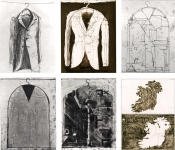
As I prepared to leave, Dick put his hand on my shoulder and told me he liked the way I had shown the prints to Andrew. It felt like a ray of sunlight on my heart. His grace and humility stay with me to this day, informing my life’s work as a master printer.
Book Signing with Alice Waters and Drawings by Patricia Curtan

Book/Shop
I met Erik Heywood a little over a year ago, soon after he launched his website Book/Shop. The website offers seasonal reading lists, library furniture and fittings, art, books, and delicious chocolate.
I was struck immediately by Erik’s passion for literature and books and his exquisite eye for design. His extensive knowledge of books and obscure publications provides a refreshing break from the culture of “insta-knowledge” and onscreen reading. Erik studied English but soon left school to sell antique furniture. He worked briefly making props for Martha Stewart, then pursued both interior design and retail branding.
In March, Erik took the keys to a quaint, 250-square-foot space in the thriving Temescal neighborhood in Oakland and set up the brick -and-mortar Book/Shop. In addition to acquiring books, he is amassing and designing several lines of merchandise related to reading: beautifully handcrafted canvas book bags detailed with fine Japanese leather, small portable bookshelves made from a variety of beautiful woods, (we bought five for the press and some for home too!), stackable bookshelf components, modernist furniture, art, and lighting.

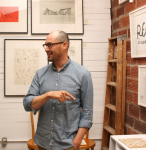
Erik’s enthusiasm about our gallery program spurred us to collaborate. He is currently featuring five of our new Maira Kalman prints on the north wall of Book/Shop, and he has invited Maira Kalman to curate a pop-up bookshelf at the press in late September. (We will keep you posted about the date.) I hope you take the time to visit Erik’s shop. His attention to fine detail is truly extraordinary.
BOOK/SHOP 482D 49th Street, Oakland, CA, 94709. Tues.-Sat. 12-5. 510-907-9649
About Time
I applaud the Supreme Court’s decision to strike down the Defense of Marriage Act. This was discrimination enshrined in law. It treated loving, committed gay and lesbian couples as a separate and lesser class of people. The Supreme Court has righted that wrong, and our country is better off for it. We are a people who declared that we are all created equal—and the love we commit to one another must be equal as well.
—Barack Obama

Wednesday’s ruling is a step forward for civil rights and civil liberties. The Supreme Court struck down the Defense of Marriage Act (DOMA) as unconstitutional, in contrast to Tuesday’s ruling, which took voting rights a step backward. We have come a long way on many fronts, but we still have a long way to go towards real equality.
Kerry James Marshall has focused his career on achieving real equality in the art world. “In the Tower: Kerry James Marshall” goes on display Friday at the National Gallery of Art‘s Tower Gallery and is Marshall’s first solo exhibition in Washington, D.C. This is the first time that the National Gallery has curated and exhibited the work of a living African-American artist.
In a conversation with NGA curator James Meyer, published recently in the Huffington Post, Marshall describes the importance of the show:
When you walk through the museum you don’t have a sense that the variety of different people who made up the nation as a whole have many any real meaningful contributions to the development of this country in the ways that people talk about its greatness. And I think to finally start to bring into a place like the National Gallery somebody who does work like mine that is not always celebratory of American ideals, that has an ambivalent and at times critical relationship to the overall story, to finally start to allow that work to be seen and those narratives to be articulated, starts to fulfill the promises that the idea of the country and the founding documents set out to guide us.
Today, 50 years after the civil rights movement’s heyday, we are at a tipping point. I hope today’s DOMA ruling and Marshall’s exhibition at the National Gallery of Art indicate that we are tipping in the right direction.
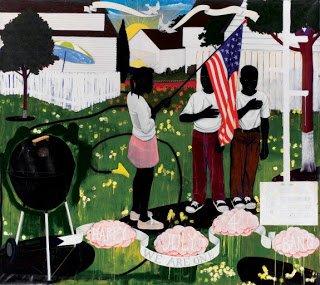
For an additional perspective on Marshall’s exhibition, please read Tyler Green’s article here:
http://blogs.artinfo.com/modernartnotes/
Paulson Bott Press Featured in Berkeleyside

To read the article, click here
